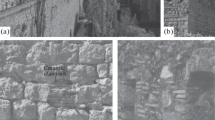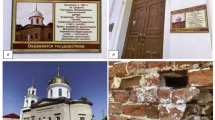The chemical and phase compositions of a ceramic material (plinth) aged more than 1,000 years that was used to construct the fortress wall were studied. Elemental analyses determined that the material had an increased carbon content of 9.50%, indicating that fuel was introduced into the raw material. This not only increased the porosity of the products but also contributed to uniform sintering of the ceramic shard and formed a glass phase up to 1000°C with an increased content of alkali oxides (R2O > 4%).
Similar content being viewed by others
INTRODUCTION
The durability of fortifications and buildings and the reduction of the capital expenses for their remodeling are currently becoming especially significant issues [1]. The structure of ceramic items with the necessary operating properties is formed during firing as the result of phase transformations [2]. Therefore, phase transformations occurring at various firing temperatures in ceramic materials technology are given special attention because they themselves are mainly responsible for the durability and operating properties of the produced items [3].
The large port city Salonika has for over 23 centuries played a large role in the life of not only Greece but also the whole Balkan peninsula. Fortification by defensive fortress walls started immediately after its establishment by King Cassander of Macedonia in 315 BCE (Fig. 1a, b ).
The current appearance of the fortress walls of Salonika (Fig. 1a, b ) is the result of construction and restoration efforts performed in the IVth century BCE until the Turkish occupation. The walls average 10 – 12 m in height over 8 km and were doubled in several places along the perimeter. Walls 4.60-m thick were constructed of rock surrounded every 2 – 3 m by layers of ceramic material (Fig. 1c ) in the form of plinths (Fig. 1d ) [4].
Aplinth is a thin fired brick that was used in construction and had a variety of shapes and rather impressive dimensions, e.g., 500 × 550 × 450 mm in ancient Rome and 300 × 350 × 25 mm in Byzantium, Greece, and ancient Russia.
RESEARCH METHODS
Elemental analyses of ceramic specimens used a JSM 6390A scanning electron microscope (SEM; JEOL, Japan). The main technical characteristics of the SEM were resolution up to 3 nm, secondary and backscattered electron imaging, 5 – 300,000 magnification, 0.5 – 30 kV accelerating potential, and up to 150 mm maximum specimen diameter.
Phase compositions of specimens were investigated on a DRON-3 automated diffractometer (Cu Kα-radiation, β-filter). Exposure conditions of diffraction patterns were U = 35 kV, I = 20 mA, 2θ = 10 – 60° for exposures, and detector movement at 2°/min. IR absorption spectra were taken on a Spekord-75JR spectrophotometer. Specimens were prepared as suspensions of powder in Vaseline oil.
EXPERIMENTAL
Table 1 presents the oxide and elemental chemical compositions of the ceramic plinth.
The elevated carbon content in the ceramic material (9.50%, Table 1) was consistent with the addition of fuel to the raw material. This not only increased the porosity of the material but also facilitated its uniform sintering and the formation of a glass phase up to 1000°C with elevated contents of alkaline oxides (R2O3, 4.87%, Table 1) and iron oxide (Fe2O3, 7.08%). Figure 2 shows a field of glass phase, the initiation of fusion of quartz with a bipyramidal habit, and porosity.
The sintering could be enhanced because of the increased reactivity of the liquid phase in the ceramics relative to their refractory components. This enabled the consumption of fuel to be decreased [5]. According to Vinogradov [6], the melt appeared initially at the boundary of particles with different chemical compositions because of the formation of low-melting eutectics based on K2O, Na2O, and Fe2O3. The refractive index of SiO2 is 1.46; of the plinth glass phase, 1.58. This indicated that an alkali-iron glass formed in the studied material.
Figure 3 shows the results of x-ray phase analysis of a specimen of the ceramic plinth. Anorthite, diopside, wollastonite, cristobalite, quartz, and a glass phase were detected in the specimens. This was also confirmed by IR spectral data (Fig. 4).
Anorthite is the feldspar CaO·Al2O3·2SiO2 and the terminal member of plagioclases. It possesses all properties typical of feldspar minerals [7]. This aluminosilicate is polymorphic, i.e., two unstable modifications besides anorthite are also known [7]. The nonmetallic materials contained only a stable modification with a melting point of 1550°C. The growth of new crystalline anorthite formations and their influence on strengthening during firing of ceramic materials is rarely mentioned in the literature. Data for the influence of ash and slag materials on the strengthening of ceramic items produced from traditional natural clays during firing at 1000 – 1100°C were reported [8]. The researchers associated the strengthening of the ceramic items with anorthite formation.
Diopside is classified as a pyroxene and crystallizes in the monoclinic system with chemical formula CaMg(Si2O6).Diopside usually includes impurities of Fe, Mn, Al, Cr, V, and Ti. The Mohs hardness of diopside is 5.5 – 6.0; density, 3.25 – 3.55 g/cm3. The material is refractory and does not melt up to 1300 – 1400°C. Diopside is used in compositions with low-melting clays to form at a firing temperature of 1050°C high-strength construction ceramics that meet high requirements [9]. Researchers compared images of compositions based on low-melting clays and diopside fired at 900 and 1050°C and found that the edges of diopside particles in the specimen fired at 1050°C had melted. Therefore, diopside at this stage reacted with the dehydration products of the clayey substance. Diopside had still not interacted with the decomposition products of the clayey masses at firing temperature 900°C and existed as a separate phase. Experience with the use of diopside rocks to manufacture construction ceramics showed that they were effectively used in masses for construction materials [9].
Hematite is the iron oxide formed at the lowest temperature. Therefore, it could be formed at low temperatures (<500°C) [7]. Hematite loses magnetic properties at 550°C and changes its crystal lattice because of a transition of the β-phase into the stable α-phase. Hematite in ceramic materials promotes the formation of iron glass that reduces their porosity and increases the mechanical strength.
Wollastonite is calcium metasilicate β-CaO·SiO2 that is polymorphic and crystallizes in two modifications (α and β) [10 – 12]. The high-temperature α-modification is called pseudo-wollastonite. Wollastonite itself is the low-temperature β-modification. According to several researchers [10 – 13], wollastonite forms a dense framework that prevents changes of the existing volume, i.e., decreases markedly compression and shrinkage of ceramic items.
Transformations of silica were found not to occur according to a Fenner diagram [5, 14]. The first transformation stage of quartz is always not tridymite but cristobalite. Cristobalite formed by silica from tridymite in the stable region (870 – 1470°C) differs from β-cristobalite by the lack of optical isotropy. Belyankin, et al. called it meta-cristobalite [15]. According to Kainarskii and Orlova [16], cristobalite can occur as an outer structureless form (at 1000 – 1250°C) and as scales (at 1250 – 1450°C), depending on the meta-cristobalite formation temperature. The formation rate of cristobalite as an intermediate phase is significantly greater than the rate of the subsequent transformation of metastable cristobalite into tridymite.
Transformations of SiO2 in clayey raw material were found to depend on the chemical and mineral compositions of the clays [14, 17, 18]. The volume effect on going from α-quartz to α-cristobalite is 15.4%, which promotes disintegration of the crystal-lattice surface [5, 14, 17 – 19]. Solid-state reactions in disintegrated, defective, and amorphous compounds occur faster because of accelerated selfand hetero-diffusion [19].
Conclusion
Elemental chemical analyses of the specimens showed increased Ca contents (4.25%) in them that promoted the formation of anorthite and wollastonite. Elevated carbon contents (14.79%) in the specimens were indicative of addition of fuel (combustible additives) to the raw material. Results of x-ray phase, IR spectroscopic, and electron-microscopic analyses showed that the high-strength properties of the ceramic plinths in the fortress walls were due to anorthite, hematite, a glass phase, and wollastonite.
References
V. Z. Abdrakhimov, “Effect of the phase composition on the durability of ceramic facing of the Shakhi-Zinda ensemble in Samarkand,” Steklo Keram., No. 3, 38 – 40 (2012).
V. Z. Abdrakhimov and E. S. Abdrakhimova, “Interrelation of the phase composition and durability of more than 800 year old brick for the example of the Kazan kremlin,” Steklo Keram., No. 2, 34 – 38 (2015).
V. Z. Abdrakhimov, “Relation between the phase composition and durability of ceramic brick older than 600 yr at the Ipat’evskii monastery,” Steklo Keram., No. 3, 29 – 32 (2013).
E. S. Abdrakhimova and V. Z. Abdrakhimov, “Chemical, phase compositions and porosity structure of the plinth brick of the White Tower (Greece) of age greater than 450 yr,” Steklo Keram., No. 4, 40 – 43 (2019).
V. F. Pavlov, Physicochemical Principles of Annealing Construction Ceramic Items [in Russian], Stroiizdat, 1977, 272 pp.
B. I. Vinogradov, Petrography of Synthetic Porous Fillers [in Russian], Izd. Literatury po Stroitel’stvu, Moscow, 1972, 135 pp.
G. I. Litvinova, V. P. Pirozhkova, and A. K. Petrov, Petrography of Nonmetallic Inclusions [in Russian], Metallurgiya, Moscow, 1972, 184 pp.
S. Zh. Saibulatov, S. T. Suleimenov, and A. V. Ralko, Ash-Ceramic Wall Materials [in Russian], Nauka, Alma-Ata, 1982, 292 pp.
V. I. Vereshchagin, A. E. Buruchenko, and V. K. Men’shikova, “Shrink-free facing ceramic material based on diopside raw material,” Sovrem. Probl. Nauki Obraz., No. 1, No. 1, 18 – 25 (2015).
E. S. Abdrakhimova and V. Z. Abdrakhimov, “Use of wollastonite in the production of ceramic articles,” Materialovedenie, No. 10, 47 – 52 (2004).
V. Z. Abdrakhimov, “Wollastonite in ceramic materials,” Ogneupory Tekh. Keram., No. 7, 41 – 47 (2006).
A. V. Abdrakhimov, I. V. Kovkov, and V. Z. Abdrakhimov, “Investigation by a regression method of the influence of wollastonite on the physicomechanical parameters of tile,” Izv. Vyssh. Uchebn. Zaved., Stroit., No. 8, 29 – 34 (2007).
V. P. Petrov, E. D. Belyankina, B. Z. Chistyakov, and V. V. Kozyrev, Wollastonite [in Russian], Nauka, Moscow, 1982, 112 pp.
V. F. Pavlov, “Transformation features of silica in clays,” Tr. NIIstroikeramiki, No. 38, 3 – 11 (1973).
D. S. Belyankin, B. V. Ivanov, and V. V. Lapin, Petrography of Industrial Rock [in Russian], AN SSSR, Moscow, 1952, 582 pp.
I. S. Kainarskii and N. G. Orlova, Physicochemical Principles of Ceramics [in Russian], Nauka, Moscow, 1956, 128 pp.
E. S. Abdrakhimova, A. V. Abdrakhimov, and V. Z. Abdrakhimov, “Polymorphic transformations of SiO2 in clayey materials of various chemical and mineralogical composition,” Materialovedenie, No. 7, 35 – 41 (2002).
V. Z. Abdrakhimov, V. V. Shevando, E. V. Vdovin, et al., “Polymorphic transformations of quartz in clays of various chemical and mineralogical composition,” Izv. Vyssh. Uchebn. Zaved., Stroit., No. 6, 40 – 47 (2007).
G. V. Kukolev, Chemistry of Silicon and Physical Chemistry of Silicates [in Russian], Vysshaya Shkola, Moscow, 1966, 250 pp.
Author information
Authors and Affiliations
Corresponding author
Additional information
Translated from Novye Ogneupory, No. 9, pp. 56 – 59, September, 2020.
Rights and permissions
About this article
Cite this article
Abdrakhimova, E.S., Abdrakhimov, V.Z. Relationship of Phase and Chemical Compositions of Durable Ceramic Material from the Fortification Wall of the City of Thessaloniki (Greece) Aged More Than 1,000 Years. Refract Ind Ceram 61, 536–539 (2021). https://doi.org/10.1007/s11148-021-00516-5
Received:
Published:
Issue Date:
DOI: https://doi.org/10.1007/s11148-021-00516-5








